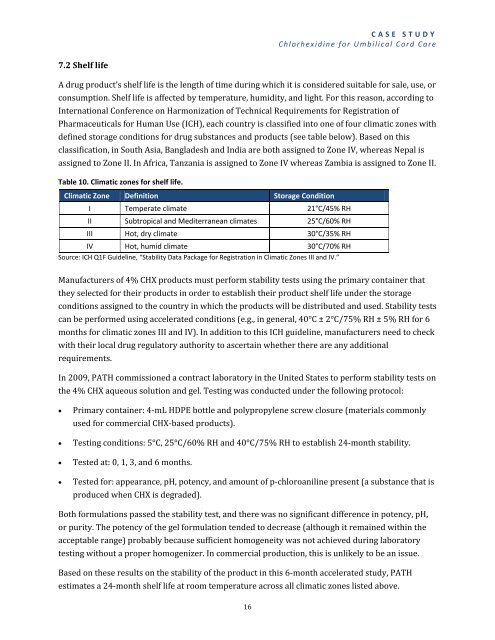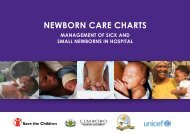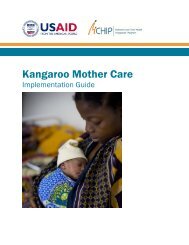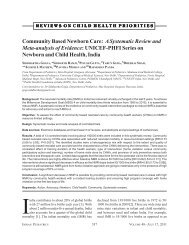Chlorhexidine for Umbilical Cord Care - Healthy Newborn Network
Chlorhexidine for Umbilical Cord Care - Healthy Newborn Network
Chlorhexidine for Umbilical Cord Care - Healthy Newborn Network
- No tags were found...
Create successful ePaper yourself
Turn your PDF publications into a flip-book with our unique Google optimized e-Paper software.
CASE STUDY<strong>Chlorhexidine</strong> <strong>for</strong> <strong>Umbilical</strong> <strong>Cord</strong> <strong>Care</strong>7.2 Shelf lifeA drug product’s shelf life is the length of time during which it is considered suitable <strong>for</strong> sale, use, orconsumption. Shelf life is affected by temperature, humidity, and light. For this reason, according toInternational Conference on Harmonization of Technical Requirements <strong>for</strong> Registration ofPharmaceuticals <strong>for</strong> Human Use (ICH), each country is classified into one of four climatic zones withdefined storage conditions <strong>for</strong> drug substances and products (see table below). Based on thisclassification, in South Asia, Bangladesh and India are both assigned to Zone IV, whereas Nepal isassigned to Zone II. In Africa, Tanzania is assigned to Zone IV whereas Zambia is assigned to Zone II.Table 10. Climatic zones <strong>for</strong> shelf life.Climatic Zone Definition Storage ConditionI Temperate climate 21°C/45% RHII Subtropical and Mediterranean climates 25°C/60% RHIII Hot, dry climate 30°C/35% RHIV Hot, humid climate 30°C/70% RHSource: ICH Q1F Guideline, “Stability Data Package <strong>for</strong> Registration in Climatic Zones III and IV.”Manufacturers of 4% CHX products must per<strong>for</strong>m stability tests using the primary container thatthey selected <strong>for</strong> their products in order to establish their product shelf life under the storageconditions assigned to the country in which the products will be distributed and used. Stability testscan be per<strong>for</strong>med using accelerated conditions (e.g., in general, 40°C ± 2°C/75% RH ± 5% RH <strong>for</strong> 6months <strong>for</strong> climatic zones III and IV). In addition to this ICH guideline, manufacturers need to checkwith their local drug regulatory authority to ascertain whether there are any additionalrequirements.In 2009, PATH commissioned a contract laboratory in the United States to per<strong>for</strong>m stability tests onthe 4% CHX aqueous solution and gel. Testing was conducted under the following protocol:Primary container: 4‐mL HDPE bottle and polypropylene screw closure (materials commonlyused <strong>for</strong> commercial CHX‐based products).Testing conditions: 5°C, 25°C/60% RH and 40°C/75% RH to establish 24‐month stability.Tested at: 0, 1, 3, and 6 months.Tested <strong>for</strong>: appearance, pH, potency, and amount of p‐chloroaniline present (a substance that isproduced when CHX is degraded).Both <strong>for</strong>mulations passed the stability test, and there was no significant difference in potency, pH,or purity. The potency of the gel <strong>for</strong>mulation tended to decrease (although it remained within theacceptable range) probably because sufficient homogeneity was not achieved during laboratorytesting without a proper homogenizer. In commercial production, this is unlikely to be an issue.Based on these results on the stability of the product in this 6‐month accelerated study, PATHestimates a 24‐month shelf life at room temperature across all climatic zones listed above.16
















